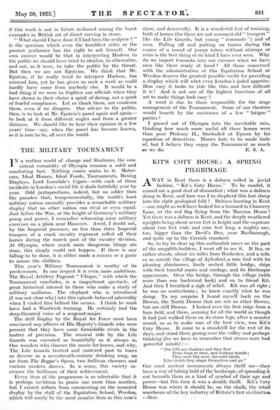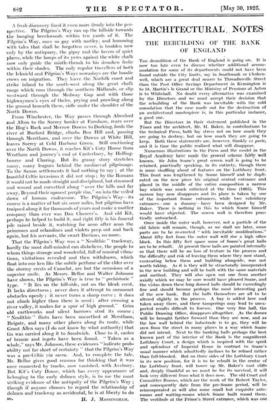KIT'S COTY HOUSE : A SPRING PILGRIMAGE
AWAY in Kent there is a dolmen called in jovial fashion, " Kit's Coty House." To 'be candid,' it caused me a good deal of discomfort ; what was a dolmen doing in Kent, and how was I to shepherd this lost sheep into the right geological fold ? Dolmen-hunting in Kent —one might as well have looked for a buzzard in Chancery Lane, or the red flag flying from the Mansion House ! Yet there was a dolmen in Kent, and the deeply weathered uprights being about seven feet in height and the capstone about two feet wide and nine feet long, a mighty one, too, bigger than the Devil's Den, near Marlborough, and quite up to the Cornish standard.
So, to try to clear up this outlandish move on the part of the megalith-builders, I went off to see it. It lies, or rather stands, about six miles from Rochester, and a mile or so outside the village of Aylesford, a rare find with its pleasing almshouses, finely arched little bridge, ships with their tuneful masts and cordage, and its Doreesque appearance. Over the bridge, through 'the village (with more than one backward look) and on to friend Kit. And then I breathed a sigh of relief. Kit was all right ; he was no scatterbrain ; he knew exactly what he was doing. To my surprise I found myself back on the Downs, the North Downs that are not as other Downs, but are still Downs. I looked over the first ridge from a bare field, and there, seeming for all the world as though it had just walked there on its stone legs, after a saunter round, so as to make sure of the best view, was Kit's Coty House. It came to a standstill for the rest of its days, and stood there gazing over the valley and perhaps thinking (for we have to remember that stones once had powerful minds) :- " The hills are shadows and they flow
From form to form, and nothing stands ; They melt like mist, the solid lands, Like clouds they shape themselves and go."
Our most ancient monuments always thrill me—they have a way of taking hold of the landscape, of spreading it out beneath them as a kind of symbol of their age and power---but this time it was a double thrill. Kit's Coty House was where it. should be, on the chalk, the retail warehouse of the key industry of Britain's first civilization --flint. - - • - A fresh discovery fixed it even more firmly into the per- spective. The Pilgrim's Way ran up the hillside towards the hanging beechwoods within ten yards of it. The Pilgrim's Way, once so gay with motley, and humming with tales that shall be forgotten never, is trodden now only by the antiquary, the gipsy and the lovers of quiet places, while the lamps of its yews against the white chalk now only guide the mistle-thrush to his drunken frolic within their shades. The only regular travellers of both the Icknield and Pilgrim's Ways nowadays are the hoodic Crows on migration. They leave the Norfolk coast and strike inland to the south-west along the great chalk range which runs through the southern Midlands, or slip westward through the Medway Gap and with those highwaymen's eyes of theirs, prying and prowling along the ground beneath them, sidle under the shoulder of the North Downs.
From Winchester, the Way passes through Alresford and Alton to the Surrey border at Farnham, rears over the Hog's Back and Merrow Downs to Dorking, fords the river at Burford Bridge, climbs Box Hill and, 'passing through Merstham, and over the Downs at White Hill, leaves Surrey at Cold Harbour Green. Still continuing over the North Downs, it reaches Kit's Coty House from Wrotham and journey's end at Canterbury, by Holling- bonnie and Charing. But its grassy story stretches many, many leagues behind the mediaeval pilgrimage. To the Saxon settlements it had nothing to say ; at the boastful Celtic invasions it did not stop ; by the Romans it would not be made straight and disciplined, but streamed and wound and curvetted along " over the hills and far away, Beyond their upmost purple rim," on into the veiled dawn of human endeavour. The Pilgrim's Way—its course is a matter of but six score miles, but pilgrims have traipsed along it for thousands of years and make a mother company than ever was Dan Chaucer's. And old Kit, perhaps he helped to build it, and right fitly is his funeral pile raised beside it, watching for aeon after aeon the primroses and celandines and violets peep out and back again, but his servants, the swart Iberians, no more.
That the Pilgrim's Way was a " Neolithic " trackway, hardly the most dull-minded can disbelieve, the people to whom things strange and wonderful, full of musical vibra- tions, visitations revealed and then withdrawn, which float. into our ken like the subtle perfume of the elder over the stormy crests of Camelot, -are but the occasions of a superior smile. As Messrs. Belloc and Walter Johnson have shown, the Pilgrim's Way is true to " prehistoric " type. " It lies on the hill-side, not on the bleak crest. It lacks directness ; never does it attempt to surmount obstacles openly ; it never turns a sharp curve ; it does not climb higher than there is need ; after crossing a river valley, it makes for a spur of high ground." Grim old earthworks and silent barrows stud its course ; " Neolithic " flints have been unearthed at Merstham, Reigate, and many other places along its route, while Grant Allen says (I do not know by what authority) that tin was carried along it to Sandwich. Close to it, caches of bronze and ingots have been found. " Taken as a whole," says Mr. Johnson, these evidences "indicate prob- ability not far short of certainty " that the Pilgrim's Way was a pre-Celtic via sacra. And, to complete the tale, Mr. Belloc gives good reasons for thinking that it was once connected by tracks, now vanished, with Avebury. But Kit's Coty House, which has every appearance of belonging to the early dolmen style, is to me the most striking evidence of the antiquity of the-Pilgrim's Way ;. though if anyone chooses to regard the relationship of dolmen and trackway as accidental, he is at liberty to do











































 Previous page
Previous page